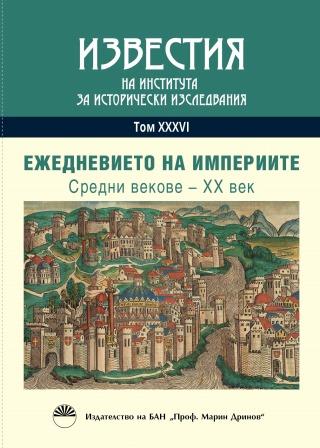Из ежедневието на един град в Османската империя в епохата на Танзимата: българите в София в средата на ХІХ век
From the Daily Life of an Ottoman Empire City in the Age of the Tanzimat: the Bulgarians in Sofia in the Middle of the Nineteenth Century
Author(s): Antoaneta KirilovaSubject(s): History, Social history, Modern Age, Special Historiographies:, 19th Century, The Ottoman Empire
Published by: Институт за исторически изследвания - Българска академия на науките
Keywords: the Ottoman Empire; Nineteenth century; social history; history of Sofia; Tanzimat
Summary/Abstract: The study is based on an abundance of sources – travelogues, articles in the National Revival press and in the Russian periodicals, personal correspondence, official documents and statistics, chronicles of Sofia’s churches and municipalities, memoirs etc. In the Introduction, entitled “A few preliminary words”, the author defines the topics, problems, concepts and the chronological framework of her research. The text is structured in several parts. The first is entitled “Sofia in the first half and the middle of the 19th century – a look from outside and inside” and it summarizes interesting information about the urban planning, architecture, life and population of Sofia, which is provided by travelers who came through the city in the first half of the 19th century. This data is presented in a synchronous narrative with the testimonies of people from the middle of the 19th century about the current state of the city. In order to make interesting analogies for the development of Sofia throughout the 19th century, eyewitness accounts from the end of the century are used. The second part “Moments from the life of the Sofia people in the middle of the 19th century” focuses on those natural and climatic factors that more or less determined the life and livelihood of the Bulgarians from Sofia. Among the natural cataclysms earthquakes, spring-summer storms and hail stood out, whose power affected the harvest and with it the nutrition and the daily life of the Sofia people. The information from the press about the holiday system of the Bulgarians in Sofia, which followed the agricultural production cycle and the Christian holiday calendar, is also interesting. The third part, entitled “The Municipality”, examines the structure and the main activities of the municipal institution in Sofia before and after its national reorganization, which took place in the mid-1860s and was provoked by the Bulgarian Easter in Constantinople on April 3, 1860. The focus is on the social conflicts in the city and on the several initiatives that most engaged the attention of the Sofia municipality during the period in question. “The School” was one of them. Unlike the traditional interpretations of the educational affairs of the Bulgarians in the 19th century, here the author has tried to present the school not as an educational institution, but as a social phenomenon that inspires the care and efforts of an ever growing group of people. A special attention is paid to the difficult awakening of the Sofia people to the need for women education, for the donation gestures for education, etc. In the last part “The Temple” the main moments from the construction of the Metropolitan Church “Holy King” (“St. Stephen” or “St. Nedelya”) are marked. The renovation took place during this period and was in the care of and a responsibility of the Sofia municipality. The processes of secularization of the public consciousness and the more and more clearly expressed nationalistic motives in the public behavior of the Sofia people in the late 50s and early 60s of the 19th century are noted. In regards to the problematic of the study, in all the outlined thematic fields, the author seeks evidence of the relationship between people in power and their subjects at a time when the idea of ‘merging nations’ became a basic doctrine of the Ottoman ruling elite.
Journal: Известия на Института за исторически изследвания
- Issue Year: 36/2021
- Issue No: 1
- Page Range: 151-190
- Page Count: 40
- Language: Bulgarian
- Content File-PDF

